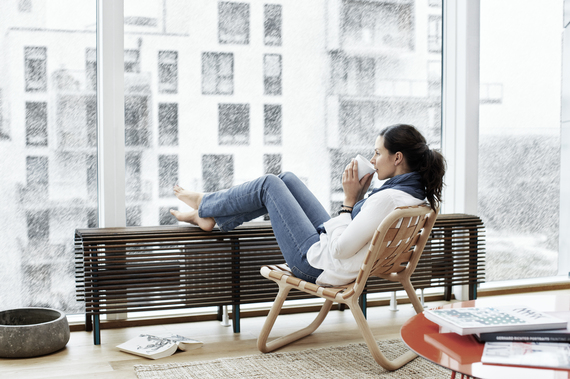As I am writing this it's 4.30 pm. It is dark outside, it is raining and the temperature is descending towards 0 degree Celcius (32°F). This feeling of Scandinavian winter has set the scene in Scandinavian literature and such dramas as Borgen and The Killing, shaping the concept 'Nordic Noir'.
When the winter season encases us Scandinavians in wet darkness we turn towards our homes. The home means a lot to the Danes, Swedes, Finns and Norwegians. It is the center of our family life, our social relations and the special Danish concept "hygge" which many foreigners visiting Denmark get to know.
Home has a strong presence in our cultural awareness, and numerous Scandinavian brands reflect this. Ikea, Danish furniture and Snøhetta, to mention a few, are great examples that have grown out of this background.
Furthermore, our unwelcoming winter climate has driven Scandinavians to come up with solutions of how to keep warm and cozy when indoors. In combination with ambitious energy efficiency legislation following the energy crises in the 1970's, Danish companies such as the ROCKWOOL Group (insulation), Vestas (wind energy) and Velux (windows) have developed leading positions in the market for energy efficient technologies. We could name this trend 'Nordic Green'.
Back in the 1970's no one foresaw the climate crises the world is facing today. Fast population growth, galloping global energy consumption and heavy use of fossil fuels are straining the earth - not to mention the geopolitical instability caused by this increased demand for energy. Innovation in new technologies will play a major role to meet these challenges but it is essential to also pick the low-hanging fruits offered by already available solutions. Future climate policies should thus build upon an increased focus on energy efficiency; securing the cheapest and most sustainable transition into a sustainable society.
If we act now and implement existing green technologies we can take a huge step towards reducing the impact of future climate change, and the first to do so can achieve important competitive advantages.
Let me illustrate by an example.
As it stands today, buildings - be it villas, apartment buildings, schools, office buildings or hospitals - account for 40 percent of Europe's total energy consumption. Converted to CO emissions, buildings today account for more than a third (36 percent) of Europe's CO emissions.
This calls for actions and initiatives aimed at diminishing European buildings' share of the total European energy consumption. Moreover, it calls for an increased focus on energy efficiency as a competitive parameter.
Denmark has a longstanding tradition of seeing energy efficiency as a prerequisite for the least costly transition to a fossil free energy system. Actually, energy efficiency is at the core of Denmark's green transition, and the facts don't hide this. Due to Danish energy policies, the nation has succeeded in decoupling energy consumption from economic growth.
Strong regulations have built a green, competitive Danish industry delivering jobs, innovations and green solutions; and due to increased energy efficiency, Danish industrial companies have over improved their competitiveness by 9 percent over the last 10 years. Last year Danish exports of energy technology amounted to almost 10 billion Euros, representing an annual growth rate of 10.7 percent. In comparison, the total Danish export grew only 0.6 percent.
However, despite this success in Denmark, the existing building mass still represents an unrealized potential as Danish buildings continue to consume 40 percent of the used energy - a situation similar to Europe as stated above.
If the renovation rate of existing building stock in the European Union is increased from 1 percent to an annual of 2.5 percent, 2 million new European jobs could be created, and the European economy would subsequently experience a kick-start with a 0.7 percent annual growth in GDP.
As I see it, there is no excuse for not putting the political framework in place enhancing action on climate change, energy efficiency and a low carbon economy - not only in Europe, but on a global scale. There are huge social benefits to be gained, the competitive advantage is clear, the impact on regional growth is obvious and the positive effect on the climate cannot be ignored. The cost of inaction now will carry devastating consequences for future generations to come.
Further, the business sector is ready to invest significantly in climate solutions. Recently, 750 CEO's from leading companies across the world urged the politicians to ensure a strong and ambitious legislative framework. This is the driver that can unlock the financial potential in the private sector.
Politicians are nevertheless reluctant as they have a much shorter political horizon and face difficulties recognizing that market forces alone cannot solve the problem in time. In Europe, energy efficiency subsidy programs have been phased out and energy bills less ambitious than needed are being passed.
When the political leaders of the world gather in Paris in December at COP21 they will once again have the opportunity to reshape the undesirable path the world is currently walking, by reassessing energy systems and consumption. It requires leadership, a break with the established ways of looking at the markets, and a willingness to see a future beyond the next election.
Where in the Arts Nordic Noir is highly regarded and is an inspiring source for authors, film producers and artists in locations all-around of the world, it is my hope that Nordic Green will face the same prosperity among decision makers in the years to come.
This post is part of a "Nordic Solutions" series produced by The Huffington Post, in conjunction with the U.N.'s 21st Conference of the Parties (COP21) in Paris (Nov. 30-Dec. 11), aka the climate-change conference. The series will put a spotlight on climate solutions from the five Nordic countries, and is part of our What's Working editorial initiative. To view the entire series, visit here.
